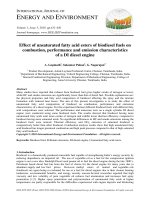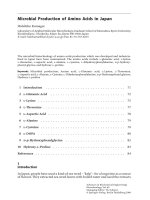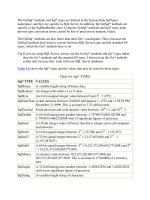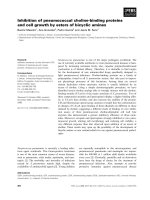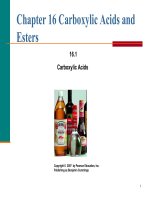ESTERS OF CARBOXYLIC ACIDS – CONVENTIONAL METHODS
Bạn đang xem bản rút gọn của tài liệu. Xem và tải ngay bản đầy đủ của tài liệu tại đây (302.84 KB, 12 trang )
4 Esters of Carboxylic Acids – Conventional Methods
Esterification of polysaccharides with carboxylic acids and carboxylic acid deriva-
tives is among the most versatile transformations of these biopolymers. It gives
ready synthetic access to a wide range of valuable products. Commercial pro-
cesses are carried out exclusively under heterogeneous conditions, due to the high
viscosity of polysaccharide solutions, the high costs of solvents, and the ease of
workup procedure in the case of multiphase conversions. One aims for completely
functionalised derivatives because partial conversion leads mainly to insoluble
polymers, specifically in the case of cellulose.
A variety of solvents have been studied and even special solvent mixtures es-
tablished for homogeneous acylation at the laboratory scale. These homogeneous
reactions permit synthesis of highly soluble, partially derivatised polymers and are
the prerequisite for the application of “state of the art” organic reagents yielding
broad structural diversity. For cellulose and chitin, the development of novel sol-
vents heralded a new era of bio-based functional polymers. Both common organic
solvents and multicomponent solvents are still widely studied for esterification
procedures yielding novel structures.
4.1 Acylation with Carboxylic Acid Chlorides and Anhydrides
Conventional esterificationsofpolysaccharides are acylationproceduresdeveloped
as heterogeneous processes, but now include homogeneous mixtures during the
esterification, caused by the dissolution of the esterified product, applying usually
carboxylic acid anhydrides or chlorides. In the case of sensitive acids, these reactive
compounds are either expensive or inaccessible, and the anhydrides and chlorides
of more complex acids are insoluble. Thus, conventional acylation is applied for
the complete conversion of all hydroxyl groups of the polysaccharide with aliphatic
(acetate to stearate) and aromatic acids (substituted benzoic acids). Over the last
60 years, an enormous amount of papers have been published (approximately
54 000 papers dealing with cellulose esters alone), and this chapter presents an
overview of present general techniques and their specific potential.
4.1.1 Heterogeneous Acylation – Industrial Processes
The most common method for the acylation of polysaccharides is the reaction
with carboxylic acid anhydride in heterogeneous phase (Fig. 4.1).
42 4 Esters of Carboxylic Acids – Conventional Methods
Fig. 4.1. Scheme of the conversion of cellulose with acetic anhydride/acetic acid
Cellulose acetate is the most commercially important polysaccharide ester of
a carboxylic acid, and is prepared industrially or at the laboratory scale by con-
version of cellulose with a mixture of acetic acid and acetic anhydride (10–40%
excess to the amount needed for cellulose triacetate formation) in the presence
of sulphuric acid as catalyst (up to 15%, w/w). It is assumed that intermediately
the mixed sulphuric acid–acetic acid anhydride is formed (usually called acetyl
sulphuric acid) generating an acetyl cation (Fig. 4.2, [85, 86]). Hence, during this
conversion, a partial sulphation is observed that suppresses the formation of a real
cellulose triacetate. Nevertheless, most of the sulphate groups introduced are ex-
changed by acetyl functions during the reaction or split off during the workup. In
the case of starch, a dehydration (water content less than 3%) and conversion at
reflux temperature is recommended for the formation of a starch triacetate [87].
Fig. 4.2. Formation of the reactive, intermediately formed acetyl sulphuric acid
For better control of the reaction temperature and to diminish the amount of
catalyst (as low as 1%, w/w H
2
SO
4
), acetylation can be carried out in methylene
chloride, which is combined with the dissolution of the products formed in the
final phase of the reaction. Most commercial cellulose acetate is produced via this
route.
An alternative is the acetylation onthe intactcellulose fibre(fibre acetylation) in
an inert solvent such as toluene with perchloric acid as highly efficient catalyst [88].
The triester is obtained applying only 15 mg catalyst on 5 g cellulose in 40 ml
acetylation mixture within 24 h at 32
◦
C. Moreover, the introduction of additional
ester groups is avoided, as observed for sulphuric acid catalysis. This method is
exploited if the superstructure of the polysaccharide should be retained, which is
essential for a number of applications, e.g. as solid phase for chiral separation in
chromatographic methods (see Chap. 10).
4.1 Acylation with Carboxylic Acid Chlorides and Anhydrides 43
Fullyacetylated cellulose can be partially deacetylated in a one-pothydrolysis to
give the widely applied acetone soluble cellulose diacetate (acetyl content ca. 40%;
DS
Ac
2.4–2.6) indispensable for spinning or shaping processes. This “synthetic
detour” is necessary because cellulose acetate samples with a comparable DS
synthesised directly from cellulose are not soluble in acetone [1, 2]. Reasons for
this behaviour are still not completely understood (see Chap. 8). Both an uneven
distribution of the ester functions along the chain or the complete functionalisation
of position 6 may contribute to the insolubility of cellulose diacetate in acetone.
A comparable behaviour is observed for the water solubility of cellulose acetate
with DS values between 0.6–0.9, which can be achieved only by homogeneous
esterification (Table 4.1) or hydrolysis of cellulose triacetates [89].
The solubility over the whole range of DS values is given in Table 4.1. The
synthesis of polysaccharide esters of longer aliphatic acids up to butyrate and the
mixed esters with acetates are basically accessible via the same path, i.e. treatment
of the polymer in methylene chloride with acetic acid and of the corresponding
anhydrides with sulphuric acid as catalyst.
Table 4.1. Solubility (– insoluble, + soluble) of cellulose acetate (obtained by hydrolysis of cellulose
triacetate) depending on the DS values
Cellulose acetate Solvent
DS Chloroform Acetone 2-Methoxy-ethanol Water
2.8–3.0 + – – –
2.2–2.7 – + – –
1.2–1.8 – – + –
0.6–0.9 – – – +
< 0.6 – – – –
A variety of alternative catalysts are available with higher efficiency, which
permit milder reaction conditions. The “impeller” method is helpful in polysac-
charide acylation. The carboxylic acids or their anhydrides are converted in situ
to reactive mixtures of symmetric and mixed anhydrides (Fig. 4.3). Chloroacetyl-,
methoxyacetyl- and, most important, trifluoroacetyl moieties are used as im-
pellers [90, 91]. Carboxylic acid esters of polysaccharides with almost complete
functionalisation can be obtained. Thus, chloroform-soluble dextran stearates and
dextranmyristateswithDS2.9arepreparedbytreatingdextraninchloroacetican-
hydride with the corresponding acids at 70
◦
C for 1 h. The presence of magnesium
perchlorate as catalyst is necessary [92].
The reactions succeed with diminished chain degradation if TFAA is used as
impeller reagent. An introduction of impeller ester functions in the polysaccharide,
i.e. trifluoroacetyl moieties are not found. A rather dramatic decrease in reactivity
is observed for the introduction of esters in the case of cellulose in the order
acetic > propionic > butyric acid [93, 94].
44 4 Esters of Carboxylic Acids – Conventional Methods
Fig. 4.3. Acylation of polysaccharides via reactive mixed anhydrides (impeller method)
Highly functionalised long-chain aliphatic acid esters of cellulose are accessible
by simply mixing carboxylic acid with TFAA for 20 min at 50
◦
C and treating the
dried cellulose at 50
◦
C for 5 h [95]. A summary of the DS values achieved and M
w
aregiveninTable4.2.
Table 4.2. DS and M
w
values for long-chain aliphatic acid esters of cellulose obtained via the impeller
method applying TFAA (adapted from [95])
Acid moiety Number of carbons DS M
w
(10
5
g
/
mol)
Acetate 2 2.8 –
Propionate 3 3.0 1.48
Butyrate 4 2.8 1.77
Valerate 5 2.8 2.15
Hexanoate 6 2.8 2.15
Enanthate 7 3.0 2.07
Octanoate 8 2.8 2.03
Pelargonate 9 2.9 3.54
Decanoate 10 2.9 2.32
Laurate 12 2.9 2.18
Myristate 14 2.9 2.87
Palmitate 16 2.9 3.98
Stearate 18 2.9 6.91
The impeller method can be applied for the synthesis of starch acetates and
cellulose benzoates with complete functionalisation. The reaction is completed
if the polysaccharide dissolves in the reaction mixture (after about 75 min at
60
◦
C, [96]).
An interesting new catalyst usable for polysaccharide modification with an-
hydrides is N-bromosuccinimide. The inexpensive and commercially available
reagent shows high efficiency for the catalysis of the acetylation of hemicelluloses
4.1 Acylation with Carboxylic Acid Chlorides and Anhydrides 45
Fig. 4.4. Proposed mechanism for the acetylation of hemicelluloses with N-bromosuccinimide as
catalyst (adapted from [98])
with the corresponding anhydride [97, 98]. A DS of 1.15 is obtained after 2 h at
80
◦
C, with 1% NBS as catalyst. Besides the mechanism proposed (Fig. 4.4), the
activating role of intermediately formed HBr is discussed.
Titanium-(IV)-alkoxide compounds, such as titanium-(IV)-isopropoxide, are
useful as esterification catalysts for the conversion of long-chain fatty acids [99].
It has been shown that the catalyst is efficient for the preparation of partially
esterified cellulose derivatives, if an appropriate solvent is used (Table 4.3).
Table 4.3. Long-chain mixed cellulose esters synthesised by titanium-(IV)-isopropoxide-catalysed
reaction in DMAc (adapted from [99])
Reaction conditions Product
Carboxylic acid Equivalent Time Temp. DS M
w
10
3
anhydride per AGU (h) (
◦
C)(g/mol)
Acetic/hexanoic 2.0/2.0 9 155 1.91/0.75 164
Acetic/nonanoic 2.0/2.0 11 145 2.03/0.70 177
Acetic/lauric 3.5/1.0 12 140 2.40/0.20 295
Acetic/palmitic 2.0/2.0 12 145 2.06/0.42 125
Acetic/nonanoic 3.0/1.0 8 145 2.44/0.26 220
